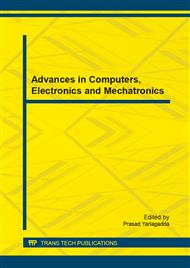[1]
Zhang L., Estrin D., Burke, J., Jacobson V., Thornton, J. D., Smetters, D. K., .. & Yeh, E. Named data networking (ndn) project. Relatório Técnico NDN-0001, Xerox Palo Alto Research Center-PARC (2010).
Google Scholar
[2]
Koponen, T., Chawla, M., Chun, B. G., Ermolinskiy, A., Kim, K. H., Shenker, S., & Stoica, I. A data-oriented (and beyond) network architecture. ACM SIGCOMM Computer Communication Review, 37(4), 181-192(2007).
DOI: 10.1145/1282427.1282402
Google Scholar
[3]
Visala, K., Lagutin, D., & Tarkoma, S., December). LANES: an inter-domain data-oriented routing architecture. In Proceedings of the 2009 workshop on Re-architecting the internet (pp.55-60). ACM(2009).
DOI: 10.1145/1658978.1658992
Google Scholar
[4]
Jacobson, V., Smetters, D. K., Thornton, J. D., Plass, M. F., Briggs, N. H., & Braynard, R. L., December). Networking named content. In Proceedings of the 5th international conference on Emerging networking experiments and technologies (pp.1-12). ACM. (2009).
DOI: 10.1145/1658939.1658941
Google Scholar
[5]
Yi, C., Afanasyev, A., Moiseenko, I., Wang, L., Zhang, B., & Zhang, L. A case for stateful forwarding plane. Computer Communications, 36(7), 779-791(2013).
DOI: 10.1016/j.comcom.2013.01.005
Google Scholar
[6]
Eum, S., Nakauchi, K., Murata, M., Shoji, Y., & Nishinaga, N. CATT: potential based routing with content caching for ICN. In Proceedings of the second edition of the ICN workshop on Information-centric networking (pp.49-54). ACM (2012).
DOI: 10.1145/2342488.2342500
Google Scholar
[7]
Eum, S., Nakauchi, K., Usui, T., Murata, M., & Nishinaga, N. Potential based routing for ICN. In Proceedings of the 7th Asian Internet Engineering Conference (pp.116-119). ACM. (2011).
DOI: 10.1145/2089016.2089035
Google Scholar
[8]
Basu, A., Lin, A., & Ramanathan, S. Routing using potentials: a dynamic traffic-aware routing algorithm. In Proceedings of the 2003 conference on Applications, technologies, architectures, and protocols for computer communications (pp.37-48). ACM(2003).
DOI: 10.1145/863955.863962
Google Scholar
[9]
Intanagonwiwat, C., Govindan, R., & Estrin, D. Directed diffusion: a scalable and robust communication paradigm for sensor networks. In Proceedings of the 6th annual international conference on Mobile computing and networking (pp.56-67.
DOI: 10.1145/345910.345920
Google Scholar
[10]
Papadopoulos, F., Psomas, C., & Krioukov, D. Network Mapping by Replaying Hyperbolic Growth. (2014).
Google Scholar
[11]
Krapivsky, P. L., Redner, S., & Leyvraz, F. Connectivity of growing random networks. Physical review letters, 85(21), 4629. (2000).
DOI: 10.1103/physrevlett.85.4629
Google Scholar
[12]
Şimşek, Özgür, and David Jensen. Navigating networks by using homophily and degree., Proceedings of the National Academy of Sciences 105. 35: 12758-12762. (2008).
DOI: 10.1073/pnas.0800497105
Google Scholar
[13]
Papadopoulos, F., Kitsak, M., Serrano, M. Á., Boguná, M., & Krioukov, D. Popularity versus similarity in growing networks. Nature, 489(7417), 537-540. (2012).
DOI: 10.1038/nature11459
Google Scholar
[14]
Dorogovtsev, S. N., Mendes, J. F. F., & Samukhin, A. N. Structure of growing networks with preferential linking. Physical Review Letters, 85(21), 4633. (2000).
DOI: 10.1103/physrevlett.85.4633
Google Scholar
[15]
McPherson, M., Smith-Lovin, L., & Cook, J. M. Birds of a feather: Homophily in social networks. Annual review of sociology, 415-444. (2001).
DOI: 10.1146/annurev.soc.27.1.415
Google Scholar
[16]
Redner, S. How popular is your paper? An empirical study of the citation distribution. The European Physical Journal B-Condensed Matter and Complex Systems, 4(2), 131-134. (1998).
DOI: 10.1007/s100510050359
Google Scholar
[17]
Watts, D. J., Dodds, P. S., & Newman, M. E. Identity and search in social networks. science, 296(5571), 1302-1305. (2002).
DOI: 10.1126/science.1070120
Google Scholar
[18]
Börner, K., Maru, J. T., & Goldstone, R. L. The simultaneous evolution of author and paper networks. Proceedings of the National Academy of Sciences of the United States of America, 101 (Suppl 1), 5266-5273. (2004).
DOI: 10.1073/pnas.0307625100
Google Scholar
[19]
Menczer, F. Evolution of document networks. Proceedings of the National Academy of Sciences, 101(suppl 1), 5261-5265. (2004).
DOI: 10.1073/pnas.0307554100
Google Scholar
[20]
Menczer, F. Growing and navigating the small world web by local content. Proceedings of the National Academy of Sciences, 99(22), 14014-14019. (2002).
DOI: 10.1073/pnas.212348399
Google Scholar
[21]
Information on at: http: /ndnsim. net.
Google Scholar
[22]
F. Bonahon, Low-Dimensional Geometry (AMS, Providence, 2009).
Google Scholar
[23]
Boguná, Marián, Fragkiskos Papadopoulos, and Dmitri Krioukov. Sustaining the internet with hyperbolic mapping., Nature Communications 1 (2010).
Google Scholar
[24]
Papadopoulos, Fragkiskos, Constantinos Psomas, and Dmitri Krioukov. Replaying the geometric growth of complex networks and application to the AS internet., ACM SIGMETRICS Performance Evaluation Review 40. 3 (2012): 104-106.
DOI: 10.1145/2425248.2425277
Google Scholar
[25]
D. Krioukov, F. Papadopoulos, M. Kitsak, A. Vahdat, and M. Bogu˜n'a, Phys Rev E 82, 36106 (2010).
Google Scholar


